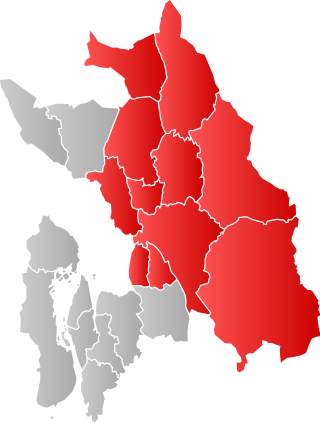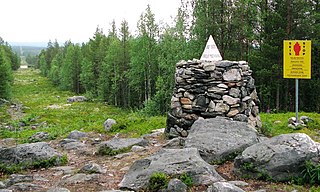
Eidsvoll is a municipality in Akershus county, Norway. It is part of the Romerike traditional region. The administrative centre of the municipality is the village of Sundet.

Lommedalen is a rural community in a small valley in Bærum municipality in the county of Akershus, Norway. The population is about 3,000 people. Lommedalen valley opens up at Bærums Verk and runs about 5 kilometers to the north.

Romerike is a traditional district located north-east of Oslo, in what is today south-eastern Norway. It consists of the Viken municipalities Lillestrøm, Lørenskog, Nittedal, Rælingen and Aurskog-Høland in the southern end, and Ullensaker, Gjerdrum, Nannestad, Nes, Eidsvoll and Hurdal in the northern end .

Peder Anker was a prominent Norwegian landowner, businessman and politician. He served as the prime minister of Norway from 1814 until 1822.

Treriksrøysa is a cairn which marks the tripoint where the borders between Norway, Finland and Russia meet. The site is on a hill called Muotkavaara, in Pasvikdalen, west of the Pasvikelva and 15 km (9 mi) southwest of Nyrud just west of Krokfjellet in Sør-Varanger municipality of Finnmark, Norway. It is the only place in Europe where three time zones meet: Central European Time, Eastern European Time and Further-eastern European Time. The tripoint can only legally be approached by the public from the Norwegian side, since both Finland and Russia maintain extensive border zones where public access is prohibited.

Nakkerud is a small village in Ringerike municipality, Buskerud, Norway. Its population is 350.

Øvre Romerike is the upper (northern) half of the traditional Norwegian district Romerike. It consists of the Akershus municipalities Gjerdrum, Nannestad, Eidsvoll, Hurdal, Ullensaker and Nes. The lower (southern) portion is known as Nedre Romerike.
Events in the year 1943 in Norway.

Skogfoss power station is a hydro electric dam in Finnmark, Norway.

Nesoddtangen is a village and the administrative centre of the municipality of Nesodden in Akershus, Norway.

Jens Stub was a Norwegian priest and politician. He was vicar on the island of Veøya and served as a representative at the Norwegian Constitutional Assembly at Eidsvoll in 1814.
Events in the year 1987 in Norway.
Events in the year 1992 in Norway.

Gjelleråsen is an area which constitutes part of Oslomarka outside Oslo, Norway.
Events in the year 1746 in Norway.

The Kvikne Copper Works at Kvikne in Hedmark, Norway were operated from 1630, and were the largest copper works in Norway in the mid-17th century. The ore discovery was reported in 1629. The first mines were called Gabe Gottes and Segen Gottes. Gabe Gottes collapsed in 1677, and in 1682 the copper works suffered severe economic losses as a ship's load of copper was taken by pirates. In 1789 the mines were largely damaged by the flooding disaster Storofsen, and this virtually ended the operation of the mines. During the first 150 years of operation about 6,960 tons of refined copper were produced from the mines at Kvikne.

Mathias Soggemoen was a Norwegian railway worker, mountain climbing pioneer and guide.

Grønlid School is located at Rutledal in Gulen municipality in Vestland, Norway. It was built in 1931 and in use as a school until 1973. During the German occupation of Norway, the building was used to house occupation forces.

The Kåfjord Copper Works was a company established in 1826 to mine copper in Kåfjord, Norway.

Sulitjelma Mines was a Norwegian mining company that extracted copper, pyrite, and zinc at Sulitjelma in the municipality of Fauske, Norway. Operations started with a test mine in 1887. From 1891 to 1933, the business was registered as a Swedish company called Sulitelma Aktiebolags Gruber. From 1933 to 1983, it was registered as a Norwegian company called A/S Sulitjelma Gruber, and from 1983 until it was shut down in 1991 the company was state-owned and was named Sulitjelma Bergverk AS.

















